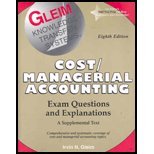Question
FIN week 5 Dis. This week we are studying the Statement of Cash Flows. Operating cash flow represents the cash that flows in and out
FIN week 5 Dis.
This week we are studying the Statement of Cash Flows. Operating cash flow represents the cash that flows in and out of the company on a day-to-day basis. For example, cash inflows come from collected revenues and cash outflows occur when the firm pays its normal day-to-day expenses. We, of course, would prefer to see a positive total on the Net Cash provided by Operating Activities, because it implies that cash inflows are greater than cash outflows. In your textbook, the author discusses 4 financial ratios associated with operating cash flows; please study these ratios. Remember that the denominator on the ratio Operating cash flow/Current maturities of long-term debt is being revised to current liabilities; therefore, we will report the ratio as Operating cash flow/Current liabilities (see discussion on page 3 of Module 5 lesson).
This week I want you to find the Statement of Cash Flow for a firm of your choosing and report the cash flow ratios. Please report and discuss 3 years of ratios for the three ratios related to debt and dividends but only the current years cash flows per share. Show numerators and denominators for all ratios and then discuss their economic meaning. It is possible that your firm does not pay dividends (you will see dividends in the financing section of the Cash Flow Statement).
Here is the example:
I went to Finance.Yahoo.com to retrieve information needed to compute the ratios. I found Net operating cash flows and cash dividends paid on the Statement of Cash Flow; I found current liabilities and total liabilities on the Balance Sheet and I found the # of shares outstanding (only available for the current year) in Key Statistics in finance.yahoo. Here are my results:
Operating cash flow/Current liabilities:
2012: 1,899/3,865 = .491
2011: 1,812/3,958 = .458
2010: 3,164/3,364 = .941
Analysis: This ratio has deteriorated significantly from 2010 to 2011 and then there was slight improvement from 2011 to 2012. Overall, this ratio pattern indicates that the firm is less able to meet its current debt obligations when compared to its 2010 levels. Keep in mind that operating cash flows include payments on current liabilities so we should not assume that the firm cannot meet its obligations if this ratio is less than 1. Instead we can only make comparisons from year to year and make statements on relative ability to meet short-term obligations.
Operating cash flow/total debt:
2012: 1,899/5,084 = .374
2011: 1,812/5,155 = .352
2010: 3,164/4,665 = .678
Analysis: Keep in mind that a firm will likely NOT generate enough operating cash flow to cover all of its liabilities. Again, we can only form conclusions associated with the firms relative position in meeting its total liabilities. Like the previous ratio, this ratio tells us that there was significant deterioration from 2010 to 2011 and slight improvement from 2011 to 2012 in the firms ability to meet its total liabilities.
Operating cash flow/share (notice that Im adding the 0s from each number to get this ratio correct!):
2012: 1,899,000,000/450,550,000 = $4.21
2011 & 2010: (n/a yes, I could find this number, but if you wish to skip this search, feel free)
Analysis: This ratio is a complement to the earnings per share ratio, which was $4.60 (diluted).
Our textbook author implies that EPS has some distortions due to accrual accounting as well as financing and investing cash flows so the operating cash flow is a purer version of EPS.
Operating cash flow/Cash dividends
2012: 1,899/619 = 3.067
2011: 1,812/555 = 3.265
2012: 3,164/505 = 6.265
Analysis: This ratio tells you how able the firm is to cover its cash dividends with its operating cash flows. Even though Nikes ratio has steadily declined, it is still able to make its dividend payment several times with its operating cash flow. Given that the company has many other sources of funds, this ratio is good overall.
Step by Step Solution
There are 3 Steps involved in it
Step: 1

Get Instant Access to Expert-Tailored Solutions
See step-by-step solutions with expert insights and AI powered tools for academic success
Step: 2

Step: 3

Ace Your Homework with AI
Get the answers you need in no time with our AI-driven, step-by-step assistance
Get Started


